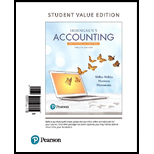
Concept Introduction:
Breakeven point: It is that point at which the company expects no
Variable and Fixed costs: Variable costs are those costs which are incurred only when units are produced like direct material, direct labor, etc, while the fixed costs are incurred irrespective of the production like salaries, rent, etc.
Net operating income: It refers to the amount earned after meeting all the costs, i.e., fixed and variable costs.
Contribution margin ratio: It is computed as the percentage of sales. The contribution is arrived at after deducting the variable costs from the sales. Its mathematical formula is (net sales − variable costs) / net sales. It reflects the left-over earnings to pay the fixed costs.
Requirement: 1
The missing values of different companies.
Requirement:2
The Company which has the lowest breakeven point.
Requirement:3
The causes of low breakeven point.
Want to see the full answer?
Check out a sample textbook solution
Chapter 21 Solutions
Horngren's Accounting, The Financial Chapters, Student Value Edition Plus MyLab Accounting with Pearson eText - Access Card Package (12th Edition)
- I need help with this general accounting question using standard accounting techniques.arrow_forwardCobalt Industries purchases a milling machine for $12,500. In addition, it incurs a sales tax of $600, shipping costs of $1,200, and $2,300 in labor costs to put the machine in place. The estimated residual value of the machine at the end of its useful life is $900. What is the depreciable base of the machine?arrow_forwardSubject: financial accountingarrow_forward

 AccountingAccountingISBN:9781337272094Author:WARREN, Carl S., Reeve, James M., Duchac, Jonathan E.Publisher:Cengage Learning,
AccountingAccountingISBN:9781337272094Author:WARREN, Carl S., Reeve, James M., Duchac, Jonathan E.Publisher:Cengage Learning, Accounting Information SystemsAccountingISBN:9781337619202Author:Hall, James A.Publisher:Cengage Learning,
Accounting Information SystemsAccountingISBN:9781337619202Author:Hall, James A.Publisher:Cengage Learning, Horngren's Cost Accounting: A Managerial Emphasis...AccountingISBN:9780134475585Author:Srikant M. Datar, Madhav V. RajanPublisher:PEARSON
Horngren's Cost Accounting: A Managerial Emphasis...AccountingISBN:9780134475585Author:Srikant M. Datar, Madhav V. RajanPublisher:PEARSON Intermediate AccountingAccountingISBN:9781259722660Author:J. David Spiceland, Mark W. Nelson, Wayne M ThomasPublisher:McGraw-Hill Education
Intermediate AccountingAccountingISBN:9781259722660Author:J. David Spiceland, Mark W. Nelson, Wayne M ThomasPublisher:McGraw-Hill Education Financial and Managerial AccountingAccountingISBN:9781259726705Author:John J Wild, Ken W. Shaw, Barbara Chiappetta Fundamental Accounting PrinciplesPublisher:McGraw-Hill Education
Financial and Managerial AccountingAccountingISBN:9781259726705Author:John J Wild, Ken W. Shaw, Barbara Chiappetta Fundamental Accounting PrinciplesPublisher:McGraw-Hill Education





